10 Essential Insights on POI Data for Market Research Analysts

10 Essential Insights on POI Data for Market Research Analysts
Overview
This article provides essential insights into the significance of Point of Interest (POI) data for market research analysts. It emphasizes the role of POI data in enhancing strategic decision-making and operational efficiency. By focusing on the features of accurate, comprehensive, and timely POI data, the article highlights the advantages of utilizing this information effectively. As a result, businesses can achieve improved consumer targeting and overall outcomes across various industries.
How can your organization leverage POI data to drive success? The implications of these insights are profound, suggesting that effective use of POI data is crucial for any market research strategy.
Introduction
The world of market research is increasingly driven by data, with Point of Interest (POI) data at the forefront of this evolution. As businesses strive to understand consumer behavior and market dynamics, the insights derived from POI data offer transformative advantages. These insights can provide a competitive edge in strategic planning and operational efficiency, making them essential for informed decision-making.
However, analysts face challenges in navigating the complexities of data accuracy, integration, and the ever-changing technological landscape. How can market research analysts leverage these insights to enhance their decision-making processes and maintain an edge in a rapidly evolving market? By addressing these questions, analysts can better harness the power of POI data.
Initial Data Offering: Access Premium POI Data for Market Insights
The Initial Data Offering (IDO) presents a dynamic platform designed to simplify access to premium poi data. By curating high-quality datasets, IDO empowers market researchers to derive actionable insights into consumer behavior and market trends. This commitment to quality not only ensures the reliability of the data but also enhances the decision-making process for analysts. Consequently, IDO emerges as a valuable resource within the fragmented information marketplace.
What does this mean for professionals in the field? The ability to rely on accurate and insightful datasets can significantly impact strategic planning and operational efficiency. With IDO, analysts can confidently navigate the complexities of market data and poi data, ultimately leading to more informed and effective business decisions. This positions IDO as an essential tool for those seeking to stay ahead in an ever-evolving market landscape.
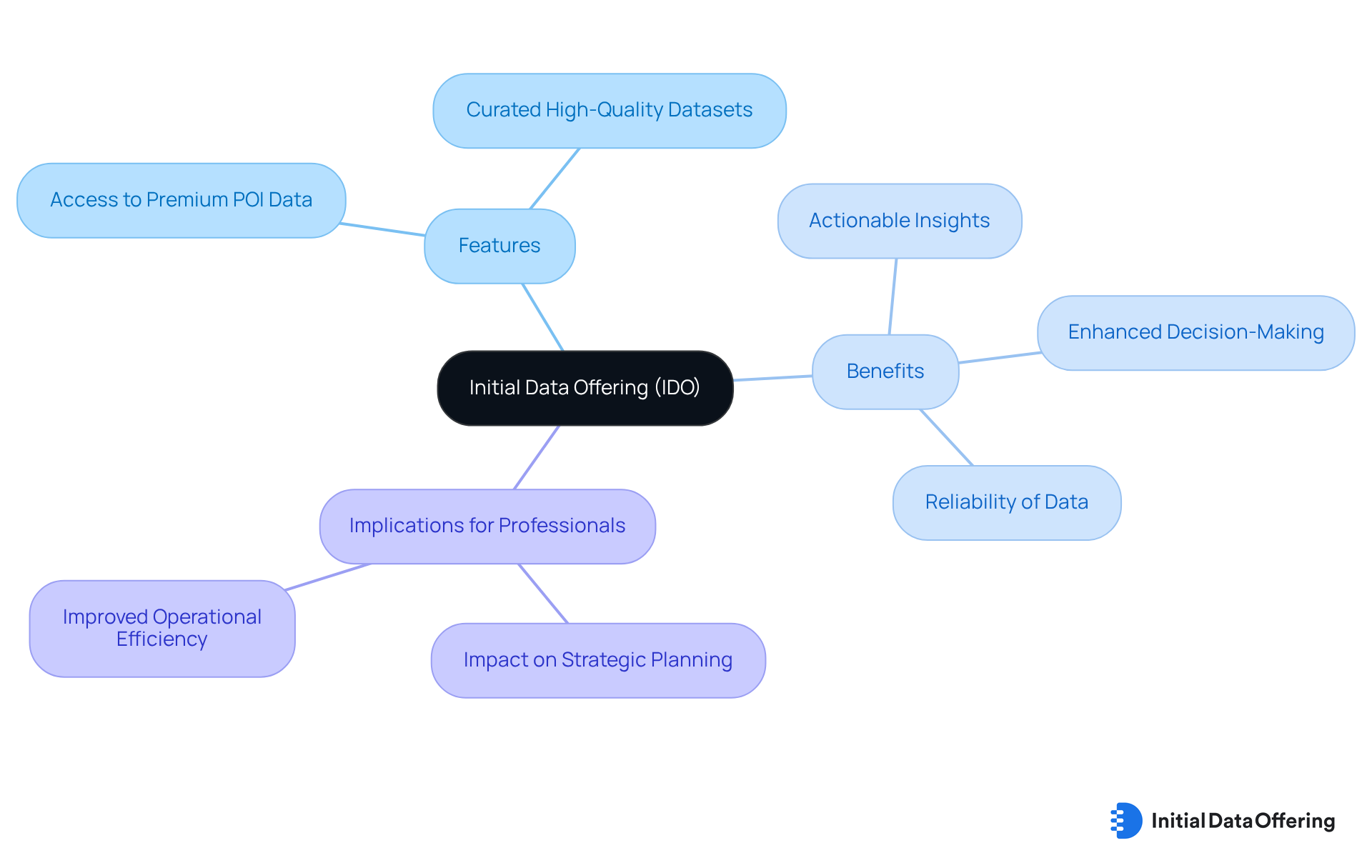
Understanding POI Data: Definition and Importance for Market Research
Point of Interest (POI) details encompass information about specific locations that attract consumer interest, such as restaurants, shops, and landmarks. This information is essential for industry analysis, providing insights into consumer behavior, location-based trends, and competitive environments. By utilizing POI information, market researchers can reveal patterns that guide strategic decisions, ultimately improving business outcomes. For instance, retailers leveraging POI information have reported a 20% rise in sales due to enhanced consumer targeting. This showcases how effective POI data is in optimizing marketing strategies.
Moreover, 88% of marketers acknowledge that POI data is crucial for targeted campaigns. This emphasizes its importance in comprehending consumer preferences and customizing marketing strategies accordingly. As the POI information solutions sector is anticipated to expand considerably, with an estimated size of around $349.56 billion in 2024, companies that invest in this information can expect increased operational efficiency and better customer engagement.
Furthermore, the growing incorporation of AI and machine learning in POI analytics enables companies to acquire deeper insights. This renders POI data an essential resource in the contemporary market research environment across multiple sectors, including retail, transportation, and tourism. How can your organization leverage POI insights to enhance its strategic initiatives and improve customer engagement?

Applications of POI Data: Enhancing Market Research Across Industries
POI data serves as a vital resource across multiple industries, including retail, real estate, and urban planning. In retail, companies leverage POI data to strategically enhance store locations by examining consumer traffic patterns, ensuring optimal visibility and foot traffic. For example, a coffeehouse chain effectively utilized POI information to analyze high-traffic areas and customer sentiment for market entry in Eastern Europe, enabling them to minimize risks and streamline their expansion process.
Real estate analysts utilize POI data to assess neighborhood amenities, such as proximity to schools, parks, and shopping facilities, significantly enhancing property valuations and investment decisions. Indeed, POI information can assist in identifying optimal sites for establishing bank branches, thus improving ATM availability in high-demand regions. Urban planners rely on POI data to identify areas suitable for development, which allows for enhanced public services and infrastructure. The city of Cremona, for instance, analyzed visitor behavior through POI information to refine its tourism strategy, underscoring the importance of these insights in informed strategic planning and decision-making across sectors.
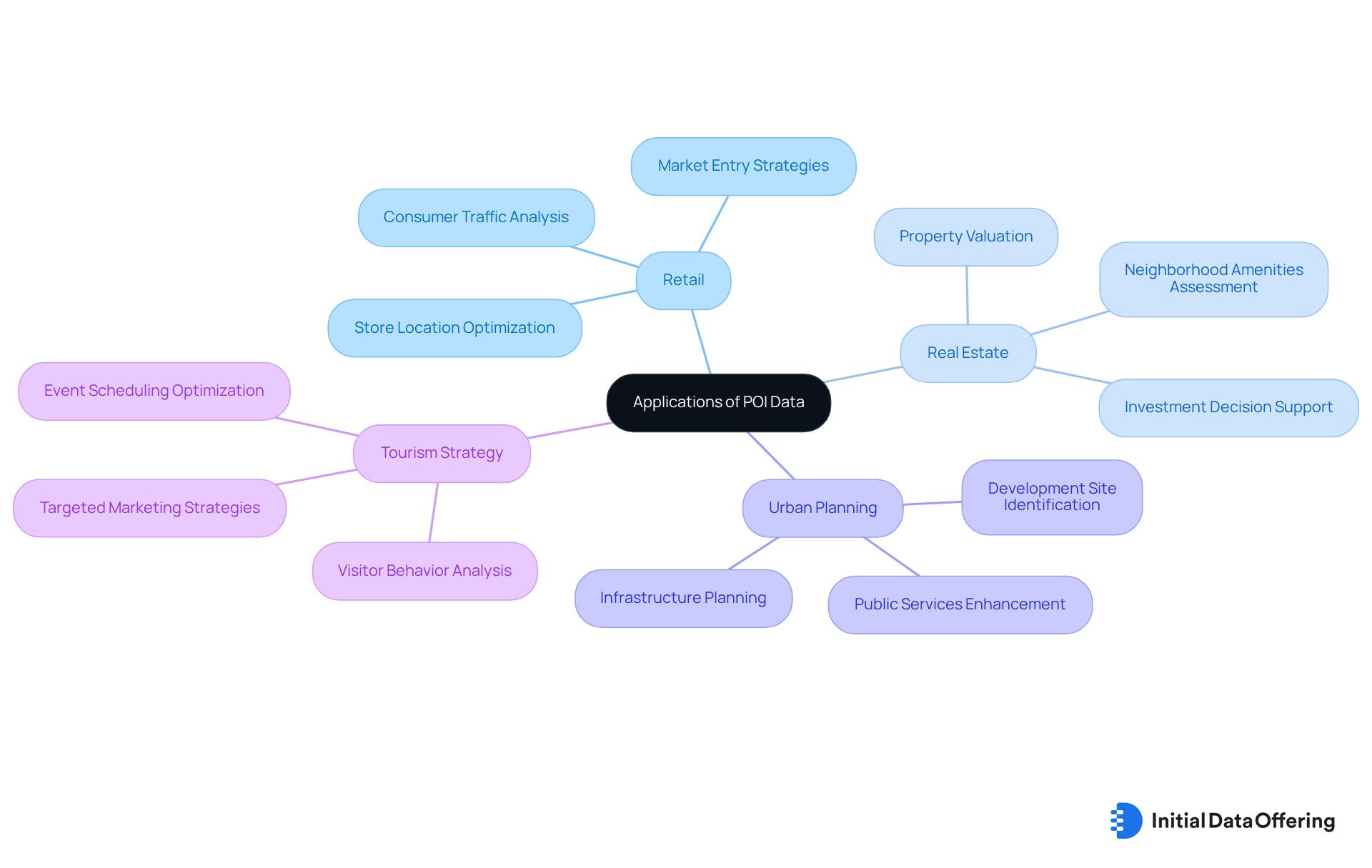
Challenges in POI Data Management: What Analysts Need to Know
Managing poi data presents several challenges, particularly concerning accuracy, consistency, and integration. Analysts face the critical task of ensuring that the information remains current and reflects real-world changes. Why is this important? Obsolete details can lead to flawed analyses, which can significantly impact decision-making.
Furthermore, the incorporation of poi data from various sources often results in discrepancies. Therefore, it becomes essential for experts to establish robust validation procedures to ensure the quality and trustworthiness of the data. This not only enhances the reliability of analyses but also fosters confidence in the insights derived from this information.

Key Attributes of POI Data: Evaluating Quality and Relevance
When evaluating POI data, analysts must prioritize several key attributes: accuracy, completeness, recency, and relevance.
- Accuracy ensures that precise location coordinates and thorough descriptions greatly improve usability, enabling accurate navigation and informed decision-making.
- Completeness guarantees that all necessary points of interest are captured, which is crucial for thorough market analysis. For instance, aggregated information can achieve very high coverage, up to 95% in most urban areas, enhancing the completeness aspect of POI details.
- Recency is vital, as outdated information can lead to misguided strategies. As noted by the Data Appeal Company, "Information that is not up-to-date can quickly become irrelevant and even detrimental to decision-making." With POI information available for a duration of up to the last five years, it emphasizes the significance of utilizing current datasets.
- Relevance is equally significant, influencing how well the information aligns with specific research goals. Analysts should choose datasets that not only fulfill their current requirements but also adjust to changing economic circumstances.
Effective evaluations of POI data in commercial research illustrate the necessity of these attributes. For example, a Geographic Information Systems leader needing high-quality POI information for Canada to enhance site selection and retail studies demonstrates that timely and pertinent datasets can result in better site selection and improved retail strategies. By concentrating on these characteristics, researchers can ensure they utilize high-quality POI data to generate effective market insights.
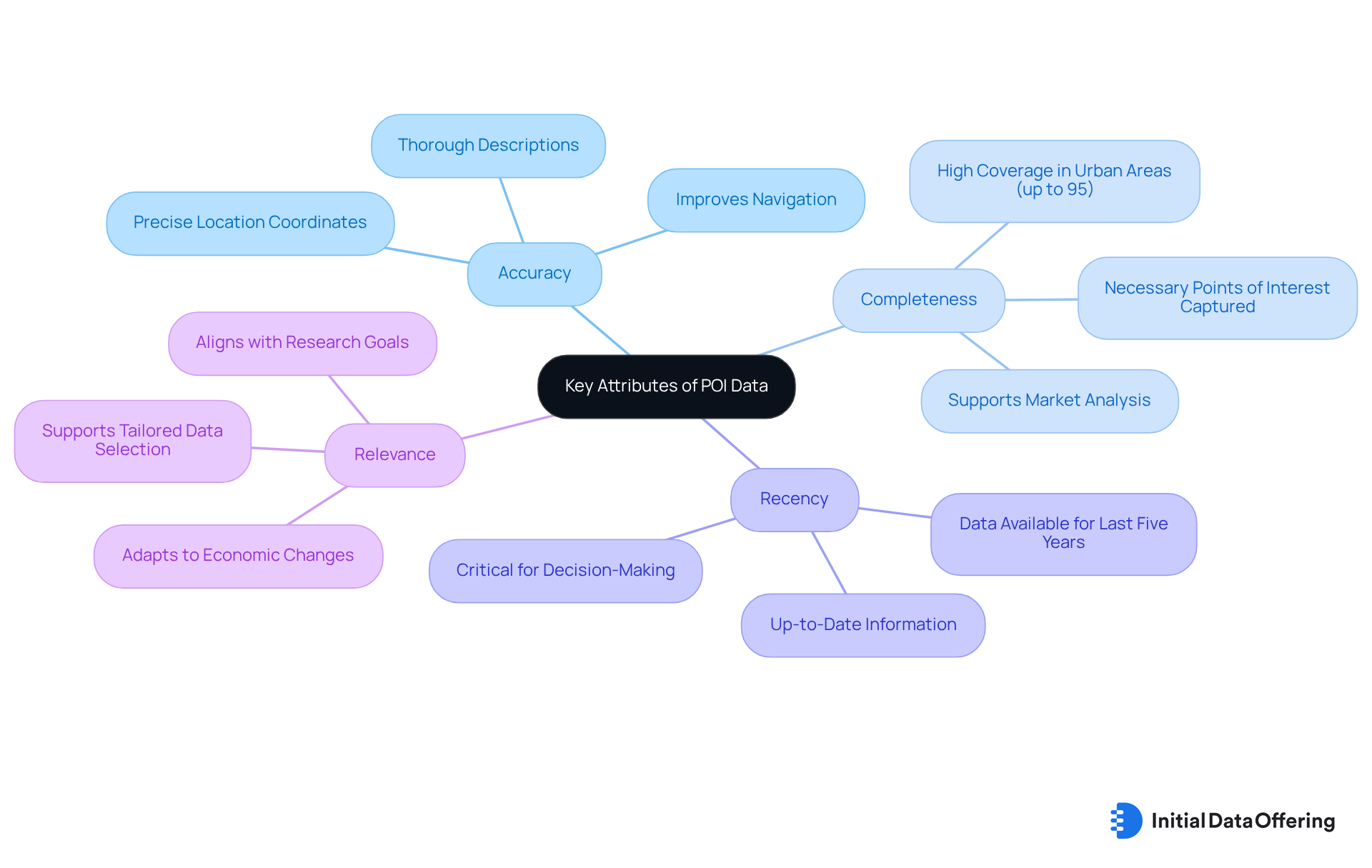
Ensuring Data Accuracy: Best Practices for POI Data Utilization
To attain high information accuracy, analysts must implement best practices that include:
- Regular validation
- Cross-referencing with reliable sources
- Leveraging automated tools for cleansing
These practices not only enhance the features of the datasets but also provide significant advantages in maintaining their integrity. Frequent updates and evaluations of datasets are essential, as mistakes during collection can amplify throughout their lifecycle. Cross-referencing multiple sources helps uncover discrepancies, ensuring reliability and completeness. Furthermore, employing automated tools simplifies the validation procedure and reduces the risks linked to manual input, which is susceptible to human errors. Regular audits are crucial; they guarantee that the information remains pertinent and precise, ultimately improving the quality of research results.
As Jagoda Myśliwiec states, "Information quality refers to the overall utility of a dataset as a function of its ability to be easily processed and utilized by end-users, while information accuracy refers to the degree to which information accurately reflects the real-world situation it is intended to represent."
How can these practices influence your work? Implementing such strategies can significantly elevate the quality of your data-driven decisions.
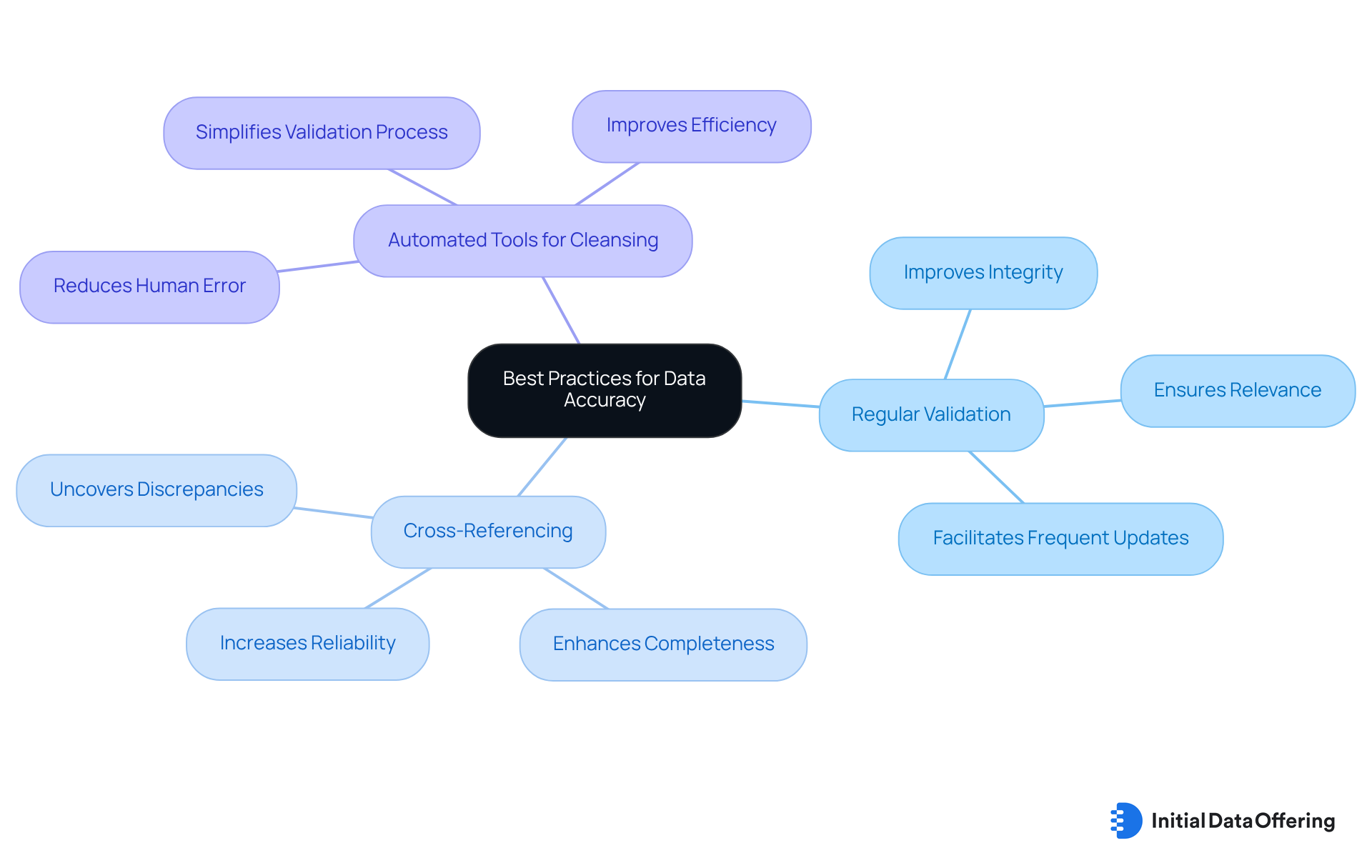
Sources of POI Data: Where to Find Reliable Information
Trustworthy sources of poi data include commercial providers, government databases, and open-source platforms. Commercial providers, such as SafeGraph and ATTOM, deliver extensive datasets that are regularly updated. This ensures users have access to the latest information. For instance, ATTOM has established a national information warehouse that includes over 158 million U.S. properties, featuring comprehensive details on various attributes and covering 99 percent of the U.S. population. Such breadth enhances its credibility and usefulness for market research analysts. Additionally, SafeGraph refreshes its Places dataset at least once a month, further underscoring the reliability of commercial information providers.
In contrast, government databases provide authoritative information, often derived from official records. However, the precision of this information can diminish over time, as businesses may not consistently update their details. Local authorities utilize poi data for urban planning and optimizing community services, yet the freshness of this data can vary. How can organizations ensure they are using the most current data when relying on these sources?
Open-source platforms, such as OpenStreetMap, offer community-contributed information, which can be particularly valuable for niche research projects. While these sources provide extensive access, the quality and dependability of the information can fluctuate, necessitating thorough assessment by evaluators. Challenges associated with open-source platforms include variability in information quality and the potential for outdated content. What measures can evaluators take to verify the reliability of these community-driven datasets?
Ultimately, evaluators should examine the reliability and update frequency of these sources to ensure high-quality information. As industry specialists emphasize, investing in trustworthy information is essential for informed decision-making across various sectors. This highlights the necessity for careful examination of both commercial and governmental datasets. Are you ready to explore how these sources can enhance your data-driven decisions?
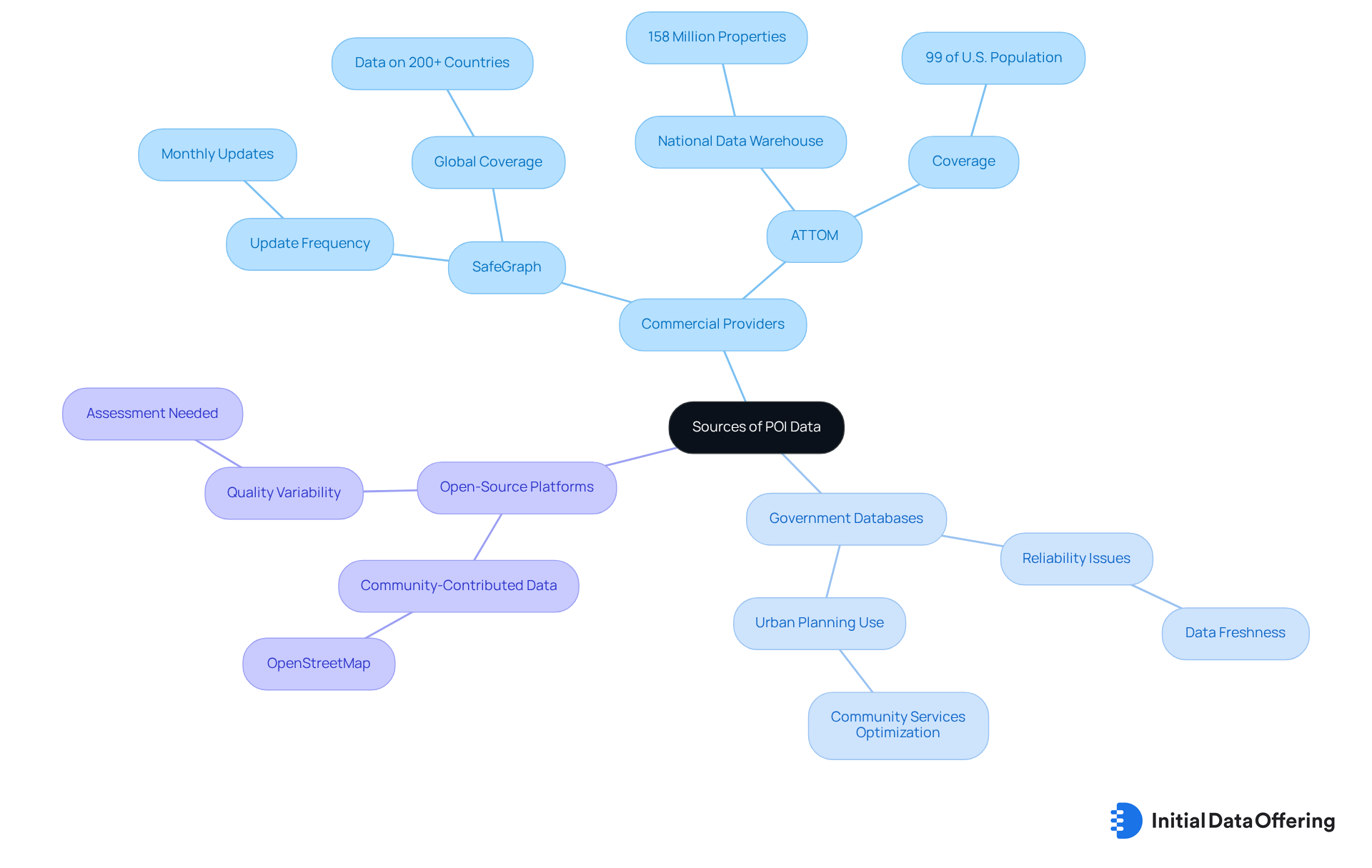
Leveraging Technology: Tools for Collecting and Analyzing POI Data
Market experts can leverage a variety of sophisticated technologies for the efficient gathering and examination of poi data. Geographic Information Systems (GIS) serve as a crucial feature in spatial analysis, enabling detailed mapping and visualization of points of interest. This capability provides analysts with the advantage of uncovering geographic patterns and relationships that inform strategic decisions. Furthermore, data visualization software enhances the presentation of findings, transforming complex datasets into accessible visual formats. This transformation facilitates understanding and communication of insights, ultimately benefiting stakeholders in making informed decisions.
Machine learning algorithms further enhance analytical abilities by recognizing trends and patterns within large datasets, allowing researchers to extract actionable insights. The integration of these technologies streamlines the analytical process, enabling professionals to make data-driven decisions that can significantly influence business outcomes. As the demand for location-based insights continues to rise, utilizing GIS tools and visual representations will be essential for maximizing the value of poi data in market research.
How can your organization utilize these technologies to drive strategic initiatives? Consider the potential impact of data-driven insights on your decision-making processes.
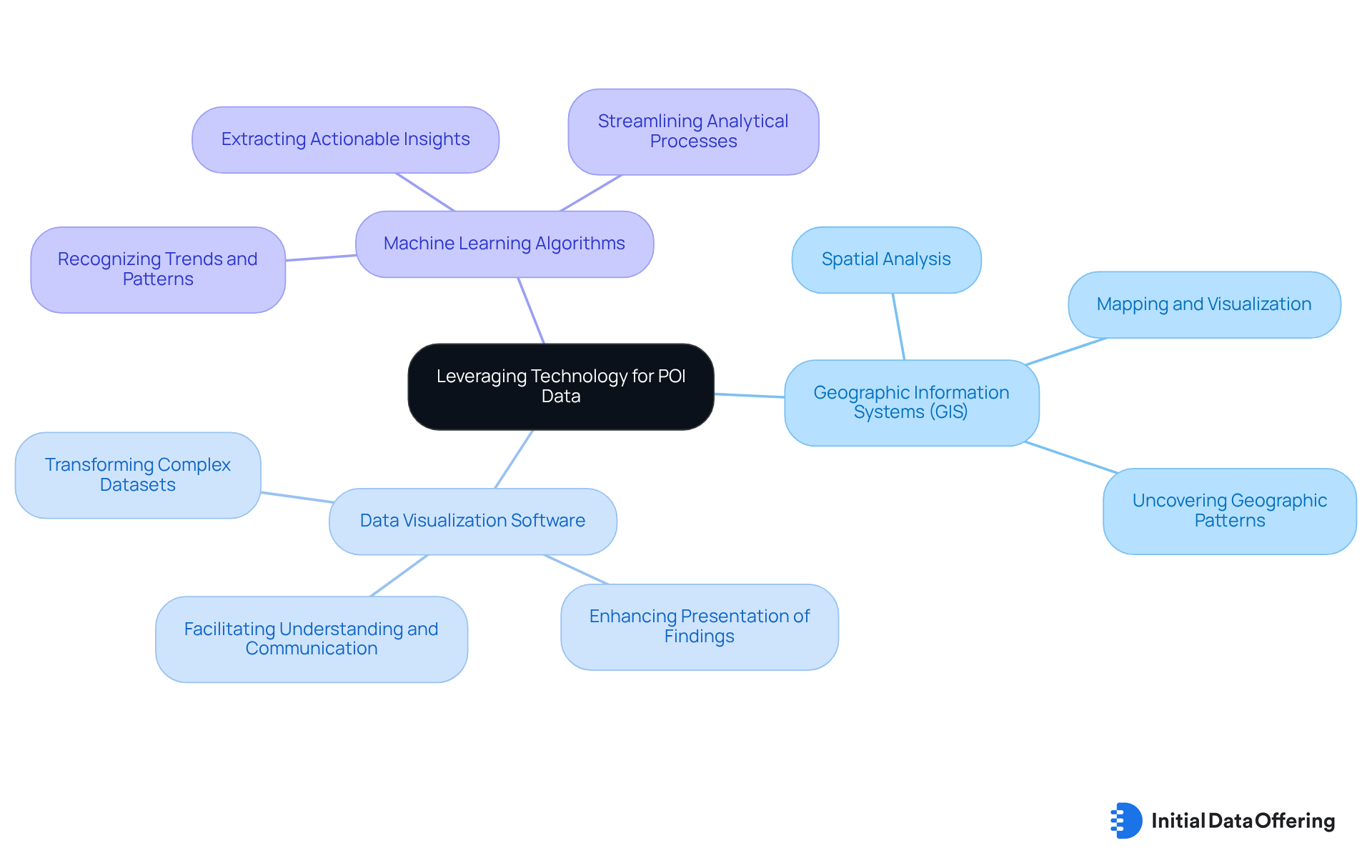
Integrating POI Data: Enhancing Research Capabilities with Existing Systems
To enhance research capabilities, analysts should prioritize the integration of POI data with existing systems, such as customer relationship management (CRM) platforms and business intelligence tools. This effective integration not only combines POI data with other pertinent datasets but also allows for a more comprehensive analysis, thereby enhancing the insights obtained from research activities. For instance, businesses utilizing POI data in conjunction with CRM systems can significantly improve their marketing strategies. In fact, 85% of retail and e-commerce companies report enhanced geo-targeted campaigns through such integrations.
Furthermore, preserving information integrity during the integration process is vital. This preservation guarantees smooth access to insights across platforms. Analysts can utilize tools like Maplytics, which enhances POI information analysis by providing intuitive visualization and smarter route planning capabilities. By merging POI data with robust business intelligence tools, organizations unlock new opportunities for efficiency, customer engagement, and informed decision-making. Ultimately, this drives better outcomes in their research initiatives. How might your organization benefit from such integrations?
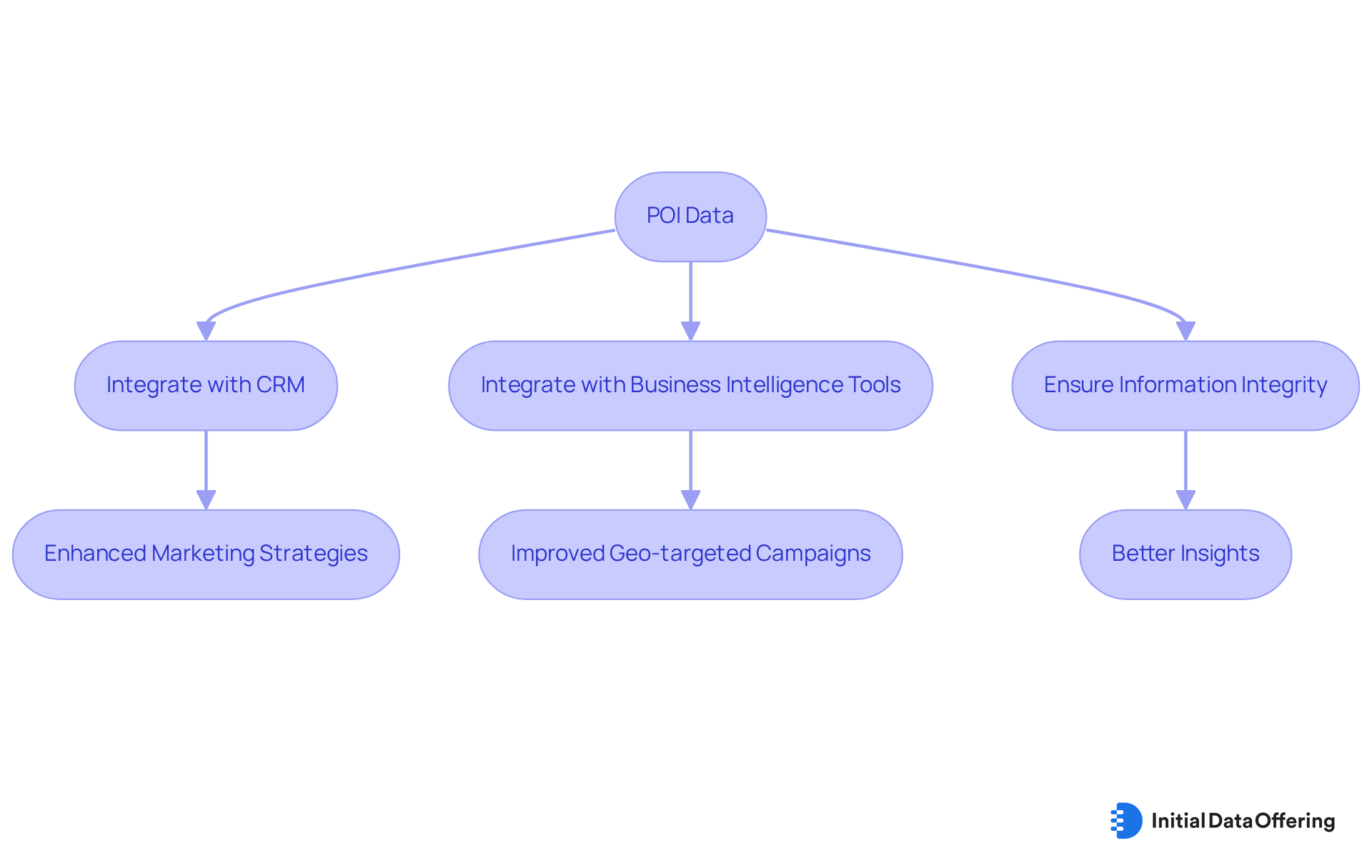
Future Trends in POI Data: What Market Research Analysts Should Anticipate
Market research analysts must prepare for significant trends in poi data, particularly the increasing reliance on real-time data and advancements in artificial intelligence (AI) and machine learning. As companies demand dynamic insights, the use of real-time poi data is projected to rise considerably. The market is expected to grow from USD 3.03 billion in 2024 to USD 8.00 billion by 2034, reflecting a compound annual growth rate (CAGR) of 10.2%. This growth is driven by the need for enhanced location-based services and data-driven decision-making across various sectors, including retail and transportation.
AI and machine learning are set to revolutionize the analysis of large datasets, providing more precise insights and strategic planning. For instance, companies like Coca-Cola and McDonald’s are already leveraging poi data to enhance product distribution and store placements, respectively. This showcases the practical applications of these technologies. Furthermore, 85% of retail and e-commerce companies report using poi data to enhance geo-targeted marketing campaigns, highlighting the widespread adoption of poi data resources in the industry. The integration of augmented reality (AR) applications will offer innovative methods for visualizing and interacting with poi data, thereby transforming traditional research methodologies.
Industry leaders emphasize that incorporating AI into POI data analytics not only enhances operational efficiency but also improves customer engagement. As noted, "AI assists in unifying execution by analyzing omnichannel information to ensure a seamless, consistent experience for consumers who anticipate frictionless shopping both online and offline." This underscores the critical role of AI in shaping the future of research, making it essential for evaluators to stay abreast of these advancements.
Moreover, the competitive landscape of the POI information solutions sector is evolving, with key players focusing on scalable and innovative solutions across various industries. In summary, the convergence of real-time data, AI, and AR technologies is set to redefine market research practices, equipping analysts with new tools and methodologies to extract actionable insights from poi data.
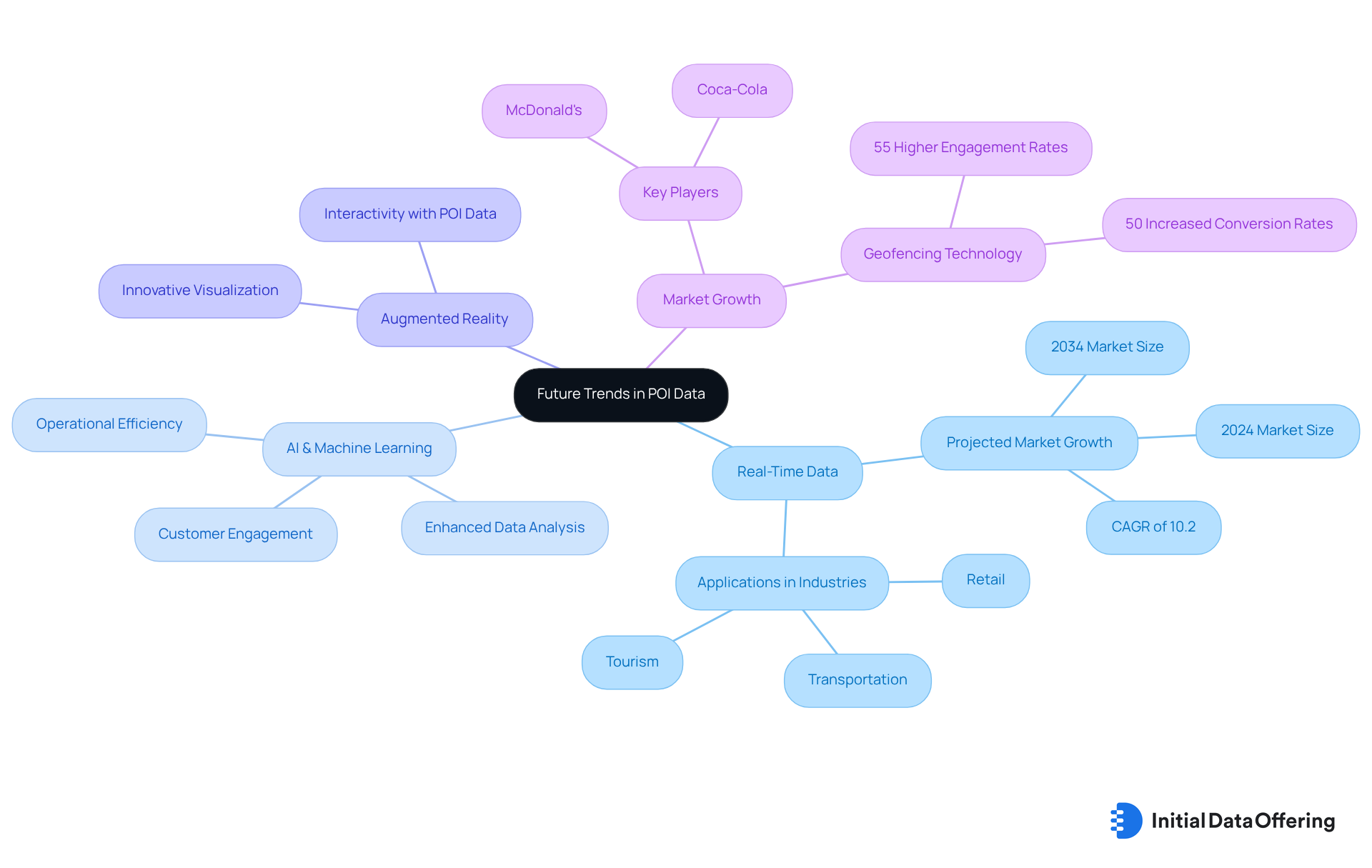
Conclusion
The exploration of Point of Interest (POI) data reveals its pivotal role in enhancing market research. Through the Initial Data Offering, professionals gain access to premium datasets that significantly improve their ability to analyze consumer behavior and market trends. This foundational element of POI data not only streamlines the research process but also empowers analysts to make informed decisions in a competitive landscape.
Key insights outlined in this article highlight the importance of POI data across various industries, from retail to urban planning. The effective use of POI information can lead to improved strategic planning, operational efficiencies, and targeted marketing campaigns. However, challenges such as data accuracy and integration must be addressed, underscoring the necessity for robust validation practices and the adoption of advanced technologies to maintain high-quality datasets.
Ultimately, as the demand for real-time and accurate data grows, market research analysts must embrace these trends and technologies to stay ahead. By leveraging POI data effectively, organizations can unlock valuable insights that drive strategic initiatives and enhance customer engagement. The future of market research is poised to be transformed by these advancements, making it essential for analysts to continuously adapt and innovate in their approaches.
Frequently Asked Questions
What is the Initial Data Offering (IDO)?
The Initial Data Offering (IDO) is a platform designed to simplify access to premium Point of Interest (POI) data, enabling market researchers to gain actionable insights into consumer behavior and market trends.
How does IDO benefit market researchers?
IDO provides reliable and high-quality datasets that enhance the decision-making process for analysts, allowing them to navigate market complexities and make informed business decisions.
What is Point of Interest (POI) data?
POI data includes information about specific locations that attract consumer interest, such as restaurants, shops, and landmarks, which is essential for understanding consumer behavior and market trends.
Why is POI data important for market research?
POI data helps reveal consumer patterns, guides strategic decisions, and has been shown to improve business outcomes, such as a reported 20% rise in sales for retailers using POI information for targeted marketing.
How do marketers view the importance of POI data?
88% of marketers acknowledge that POI data is crucial for targeted campaigns, emphasizing its role in understanding consumer preferences and customizing marketing strategies.
What industries benefit from POI data?
POI data is valuable across multiple industries, including retail, real estate, and urban planning, helping companies enhance location strategies, property valuations, and public service planning.
Can you provide an example of how POI data is used in retail?
A coffeehouse chain used POI data to analyze high-traffic areas and customer sentiment for market entry in Eastern Europe, which helped minimize risks and streamline their expansion process.
How do real estate analysts utilize POI data?
Real estate analysts use POI data to assess neighborhood amenities, such as proximity to schools and shopping facilities, which enhances property valuations and investment decisions.
What role does POI data play in urban planning?
Urban planners rely on POI data to identify suitable development areas, which aids in enhancing public services and infrastructure, as demonstrated by the city of Cremona's analysis of visitor behavior for its tourism strategy.
How is AI and machine learning impacting POI data analytics?
The incorporation of AI and machine learning in POI analytics allows companies to gain deeper insights, making POI data an essential resource in contemporary market research across various sectors.